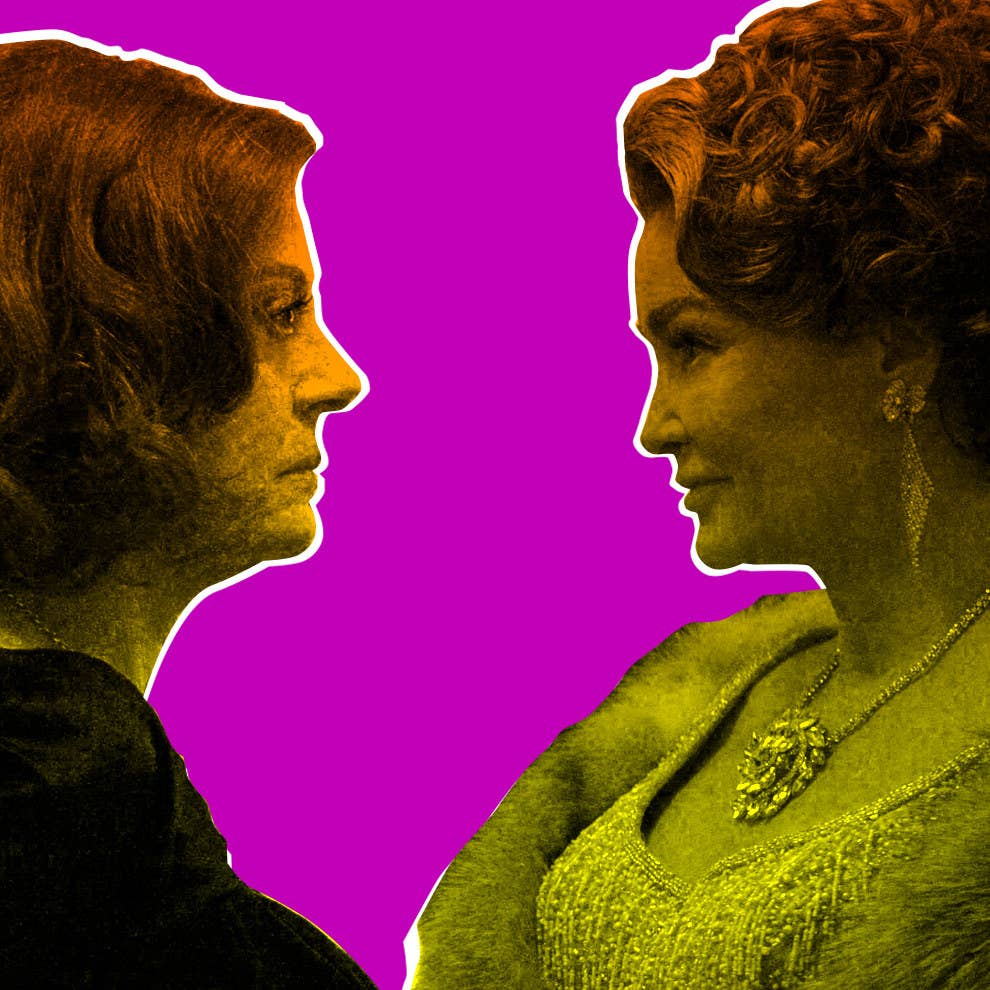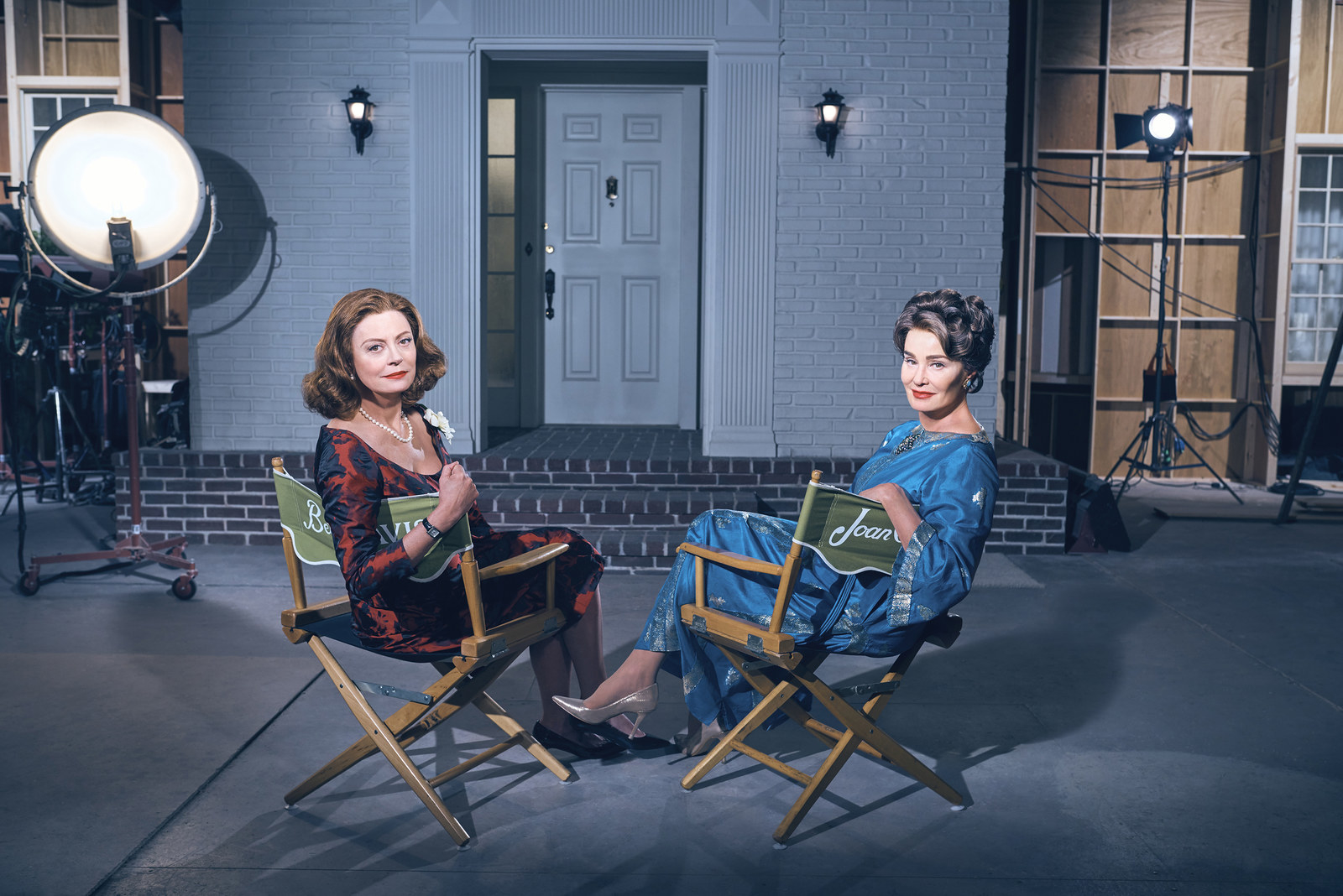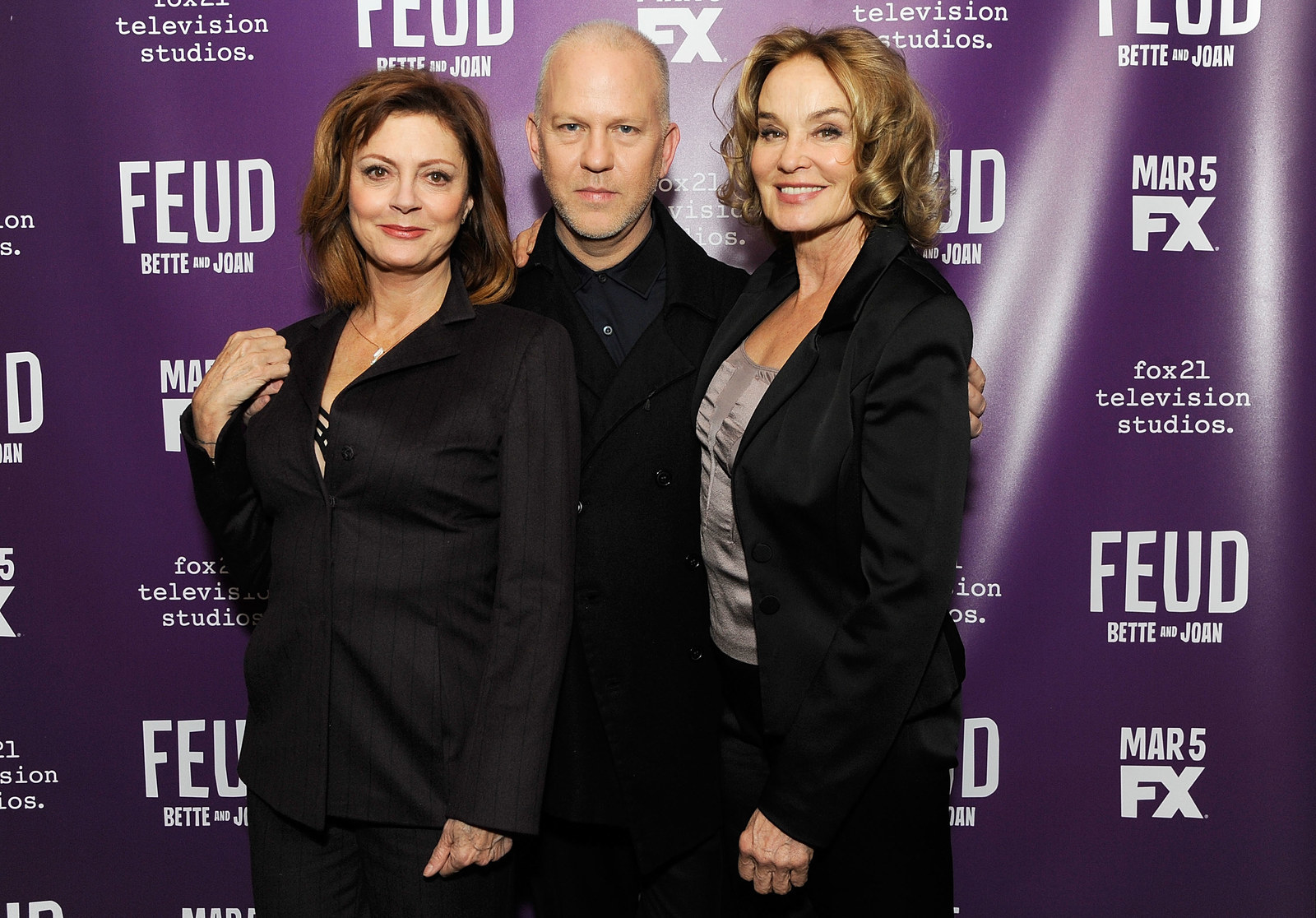
Ryan Murphy has created a new role for himself as an expert chronicler of scandalous episodes in tabloid history, with 2016’s award-winning miniseries The People v. O.J. Simpson: American Crime Story and FX’s newest Murphy installment, Feud: Bette and Joan, a fictionalized account of the reputed rivalry between stars Bette Davis and Joan Crawford. Whether the angle is crime or feuds, Murphy makes critically acclaimed miniseries by tackling the kind of stories that usually get ripped from tawdry headlines and churned out as melodramatic Lifetime movies.
What distinguishes his approach is the way he reinterprets these stories — after some time has passed — through a supposedly feminist lens that changes our understanding of the way they were originally told. Reviewers hailed the way he made a feminist hero out of the maligned Marcia Clark in the O.J. miniseries, and Vanity Fair has already called his retelling of the feud between Crawford and Davis fiercely feminist.
But the limitations of Murphy’s feminism, which works best when recuperating the image of marginalized white women, became evident in the shift from Crime to Feud. His reinterpretation of the Simpson case confronted widely held assumptions about the trial by ridiculing the fragility of the male egos on Simpson’s dream team, and making Marcia Clark the unquestionable moral winner of his version of the story. In contrast, Feud doesn’t question the basic premises of the narrative surrounding Davis and Crawford’s supposed antagonism. It focuses on two celebrated actresses — hardly in urgent need of reconsideration, unlike Clark — and compiles myths and gossip about them into a neat, verging-on-instructive narrative about women in Hollywood. It does little to radically alter our understanding of Davis and Crawford, and by relying on the concept of the female feud, Murphy ends up reproducing tired tropes that don’t challenge — or expand — representations of women.

Murphy’s approach to tabloid storytelling first became evident in the structure of The People v. O.J. Simpson. For many people the O.J. Simpson case was about the guilt or innocence of Simpson himself, but Murphy’s miniseries turned the trial into a story of numerous feuds, especially one between the defense team (centering on Johnnie Cochran) and the prosecution (centering on Marcia Clark). The difference between Cochran's and Clark's portrayals tells us where the story's sympathies lie and exposes some of the limits of Murphy’s approach when race and gender intersect.
Despite its white feminist sympathies, The People v. O.J. Simpson worked because there isn’t one neat narrative through-line.
The show reconsiders — almost mocks — the role of the men in the story. While lawyers and courthouses are usually represented as spaces of masculine stoicism and rationality on television, Murphy’s version portrayed Simpson’s legal team as a parade of male divas, especially Robert Shapiro (played with campy gusto by John Travolta) and, perhaps the ultimate diva of them all, Johnnie Cochran (played by Courtney B. Vance).
Cochran is portrayed as a powerfully pragmatic user of racial politics, alternately driven by sincerity and ego. His wife kiddingly goads him into taking the case by reminding him that he’ll be upset if he sits on the sidelines and someone else gets Simpson off. Murphy “humanizes” Cochran by providing background scenes of him being racially profiled — even as an assistant district attorney — in a powerful moment where his daughters witness his humiliation by a police officer. But otherwise there is little sense of his vulnerability as a black man; he is mostly in control, and his ostensible goal — exposing police brutality — always seems compromised by his pursuit of media power and his expensive suits. When he's accused of infidelity and domestic violence in the tabloids, it's almost as if we’re meant to think of him as parallel to O.J.
In contrast, Clark is depicted as a saintly underdog: She’s not motivated by fame or money; there’s a purity to her purpose as she seeks justice, especially for Nicole Brown Simpson, whom she identifies with as a victim of rape. She is subjected to tabloid attacks questioning her professional competence, motherhood, looks, even her nude body, but she never wavers in her efforts. It makes sense that Sarah Paulson ultimately won the Best Actress Golden Globe and Emmy for her portrayal of Clark: In many ways, her role was the most powerfully revisionist aspect of Murphy's story.
Despite its white feminist sympathies, The People v. O.J. Simpson worked because there wasn’t one neat narrative through-line. By shifting from the jurors to the media to people on the streets, the series gave us a flavor of how the race and gender issues raised by the O.J. case circulated through American culture at the time. In other words, this story covers not only the mechanics of the trial, but also how it was received and what it meant in terms of racial and gender politics in the country.

At first glance, the rivalry between Bette Davis and Joan Crawford appears to be a perfect candidate for Murphy’s approach. Instead of one maligned white woman, there are two; instead of a droning trial, the material is already inherently entertaining: a catty feud. But in a way, this is precisely the problem with the story: There appears to be no real urgency or reason to revisit the tale. Indeed, watching Feud makes it clear how much the racialized antagonism between Marcia Clark and Johnnie Cochran — and the opposition of white femininity and black masculinity — animated The People v. O.J. Simpson. Stripped of that multilayered drama, Murphy’s storytelling loses steam.
Feud chronicles the moment when Crawford (played by Jessica Lange) and Davis (played by Susan Sarandon) came together to revive their moribund careers through the 1962 camp classic What Ever Happened to Baby Jane? It unravels their backgrounds and trajectories to contextualize the story of how they were pitted against each other — by gossip columnists (namely Hedda Hopper), directors (particularly Robert Aldrich), and the studio system (in the form of studio head Jack Warner) throughout the making and aftermath of Baby Jane.
Early in the first episode, Catherine Zeta-Jones, playing Olivia de Havilland (a classic Hollywood actress who got embroiled in her own feud with her sister Joan Fontaine), gives us her theory about feuds in a “documentary” interview format that occasionally provides background for the show, acting as a kind of Greek chorus: In her view, feuds are never about hate. This also happens to be Murphy’s take on such battles. “Great feuds are never about being bitchy or anger, there's always some huge amount of pain behind it,” he told E! News. In many ways, this sentimental explanation of the causes of these conflicts explains Feud’s limits: the series doesn’t question the centrality of feuds as a metaphor for representing women, nor is it interested in clarifying what was gossip or myth. Indeed, the women in the faux documentary simply parrot Murphy’s own ideas about feuds, and this legendary one in particular.
The series takes the women’s antagonism at face value and “explains” it through their biographies. If some early reviewers noted that “a slight edge goes to Lange” in terms of performance, this is probably because Joan Crawford’s image was the one most in need of the kind of reconsideration that Murphy excels in. Her public narrative was forever altered by that other camp classic movie, Mommie Dearest, based on her daughter’s best-selling memoir about surviving Crawford’s abusive behavior. Feud is in part a reinterpretation of the way Crawford is remembered. We learn, in a conversation between her and Bette Davis, that Crawford was sexually abused by a stepfather and banished to a convent by her mother. Instead of the hysterical Mommie Dearest Crawford who screams at her daughter about wire hangers or forces her to eat raw meat, we get a less stringent, more caring Crawford who allows her younger daughters to assert their own agency by removing the preposterously girlish bows that she made them wear.

Murphy keeps saying in public that the series was not intended to be camp, but he is obviously intrigued by the campy catfight elements between Crawford and Davis. After Baby Jane became a success, Davis received an Academy Award nomination, but Crawford didn’t. Murphy clearly savored this depiction of Crawford's campaign against Davis’s Oscar win, and her scheming to ensure that she — and not Davis — would end up on the stage to receive a statue: these maneuvers are carefully re-created down to the moment when Crawford has glitter sprinkled in her elegantly gray hair — in slow motion — to go with her sparkly dress.
In the traditional narrative of Hollywood history, Crawford was considered more of an image-conscious movie queen than an actor, while Davis was seen as a craft-driven thespian spurning Hollywood machinations, and that fundamental narrative remains intact in Feud. Crawford, for example, allies herself with Hedda Hopper (who has become as much an object of Hollywood nostalgia as any actress) to campaign against Davis’s Oscar nomination for the film, while Davis stays away from Hopper, considering her an enemy of women.
“I think people at first blush might think, ‘Oh, this show is glorifying women tearing each other apart,’” Murphy explains. “Actually, this show is condemning it, and trying to show women that's not the way to go.” But by relying on the concept of the female feud, Murphy ends up reproducing many tropes that should probably be reconsidered. For example, after Crawford fails to get an Oscar nomination, the events at her house are framed as a horror show: Her loyal German maid, Mamacita, unhooks all the phones in the house and they beep in ominous unison; the scene ends with a shot of the house from outside as we hear her hysterical scream.
Further, the motivation for many fights gets reduced to the idea of one woman’s jealousy over another’s beauty: Davis and Crawford are shown using their joint powers to get a younger minor player in the movie fired; at another moment, Davis’s daughter, B.D. Hyman, accuses her mother of being jealous of her sexuality because her own moment has passed. In truth, Hyman, now a famous pastor who wrote a nasty tell-all about Davis, My Mother’s Keeper — followed by Christian self-help books about surviving controlling parents — also said that her mother encouraged her to experiment with her sexuality. Davis was upset that she’d been a virgin when she married and wanted something different for her daughter.
The series doesn’t question the centrality of feuds as a metaphor for representing women; nor is it interested in clarifying what was gossip or myth.
While Crime Story used the theater of the Simpson trial to explore race and gender in America, Feud isn’t interested in examining issues of gender through feuds. There are no insights into why such conflicts resonate so much, why the public likes to read about them, why people tend to think about women in opposition to each other, why feuds become symbols of larger questions. This is a top-down story of Hollywood production rather than consumption. Hopper seems to side with Crawford out of convenience because Davis refused to play her games, but there is no exploration of what they represented culturally to fans or to the public at the time.
As if to make up for this lack, the miniseries tacks on two subplots meant to convey a sense of history from below, perhaps as a way of giving the story larger cultural purchase. One involves Victor Buono, a closeted gay actor on Baby Jane who gets arrested during a raid at a gay cinema. Davis pays his bail and brings him back to her place, where they joke about how she's a camp icon for gay men. There is a touching quality to the scene, but Buono simply ends up serving as an audience for Davis’s monologue about her daughter, and it becomes clear he is being used only to depict Davis’s compassion and her knowledge about gay audiences.
Another subplot involves Mamacita, Crawford’s loyal maid, and director Robert Aldrich’s assistant. The two women in service of powerful figures come together as Mamacita helps the assistant get a new movie script to Crawford that the assistant might direct. After Crawford rejects it, Mamacita tells the assistant: Soon women will be the biggest consumer of movies and female directors an inevitability. It’s hard to tell whether this subplot was meant as an ironic commentary on how that never came to pass, or the kind of smug historicism that somehow makes misogyny seem like a sin of the past. Either way, it fails to tell us anything new about Crawford or Davis or the cultural implications of their antagonism.

Murphy likes to say things haven’t changed much for women (especially older women) in Hollywood, implying that he’s making a difference by making a space for them. But his roles for older women haven’t changed things much either. Lange herself first entered the Murphy universe in American Horror Story, playing a glamorous and creepy Southern belle bent on avenging her husband’s infidelity — not so different from Bette Davis’s role as Baby Jane or even Sunset Boulevard’s Norma Desmond. (Recently Glenn Close returned to Broadway by reprising her role as Desmond, another delusionally grotesque diva who turns into a scandalous horror show.) It's almost as if women of a certain age can only find roles as delusional and gothic spectacles of hysteria or lack of self-awareness.
But all the jokes in Feud comparing Crawford and Davis’s pettiness to masculine battles and war seem to have lost currency at a moment when the pettiest aging diva of all is in the White House. Is Donald Trump not Norma Desmond — a septuagenarian drama queen obsessed with his self-image, looking for new screens that will tell him how handsome and big-handed he is? A drag queen version of Feud with Trump might be a more scathing commentary on gender than Murphy’s vaguely revisionist account.
When reality is more interesting than our fantasies, it's time to find new stories to tell, and Feud reminds us that only so much change can be accomplished by continuing to reproduce existing narratives. Though we tend to think of scandal as a form of boundary-breaking, only certain figures are even allowed to break the boundaries that will then allow for the reconsiderations that Murphy undertakes. The forthcoming installments of Feud and American Crime Story will feature the type of scandalous white woman Murphy loves: Monica Lewinsky and Princess Diana. Tellingly, the only woman of color depicted in the recent wave of ’90s nostalgic scandal television was Anita Hill, in HBO’s Confirmation. But as a Slate critic noted, in contrast to the antics and diva fits allowed of scandalous white women: “She is a paragon of decency, strength and thoughtfulness throughout. If she is anything more human than a saint in real life, this movie won’t tell.”
In her recent Oscars speech, Viola Davis exhorted writers to turn to graveyards to exhume the stories of people whose dreams never came true. While Murphy turned to the graveyard for this first installment of Feud, he has exhumed women who have been celebrated — and endlessly reconsidered — by American culture in both life and death. It is time to uncover untold stories that will highlight important intersections, illuminate new angles, perhaps even create new metaphors, to represent the complexities of scandalously difficult — or scandalously erased — women’s perspectives.
